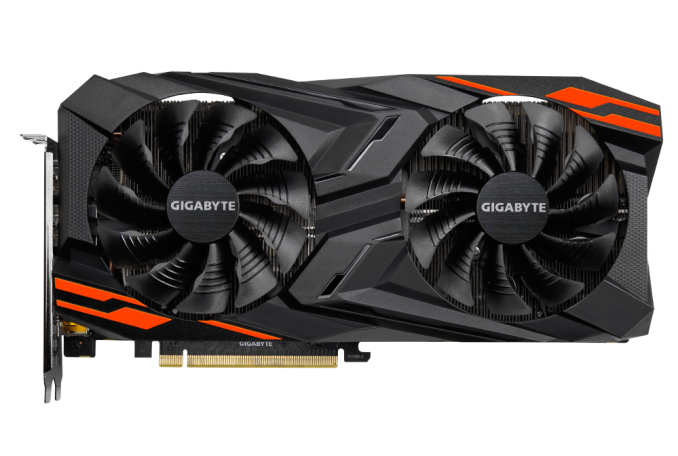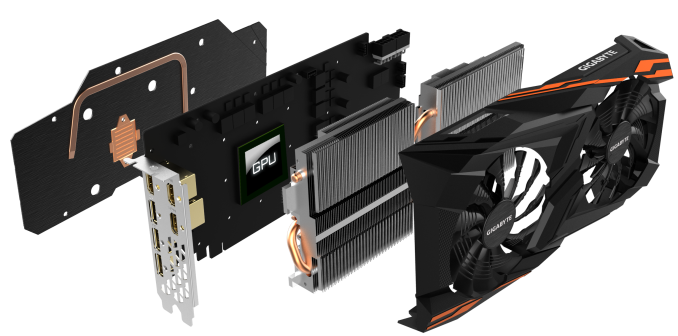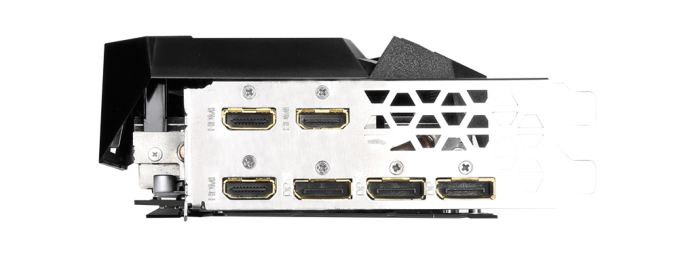Gigabyte Unveils Radeon RX Vega 64 Gaming OC Windforce 2X, To Release RX Vega 56 Version Soon
by Nate Oh on December 7, 2017 3:00 PM EST
Adding on to the recent slew of custom RX Vega announcements, last week Gigabyte announced the Radeon RX Vega 64 Gaming OC 8G, featuring their dual-fan Windforce cooling system. The 2.5 slot width card comes with a very mild factory overclock of 1560MHz boost and 1276MHz base, but otherwise brings the usual amenities of high-end custom designs: 12+1 power phases, backplate with copper slug and heatpipe, and zero fanspeed idle under their “3D Active Fan” branding, where fans turn off under lower temperatures or loads.
The rest of the Windforce 2X design is fairly standard for Gigabyte’s high-end models. Underneath the two 100mm alternate spinning fans, the aluminum heatsink’s five copper heatpipes make direct contact with the GPU, and presumably the HBM2 as well. On the rear, the metal backplate features a copper plate behind the GPU and a copper heatpipe, features that are not typically present in Gigabyte’s budget models. Altogether, the heatsink with rear copper plate and heatpipe complex is an interesting design choice to complement the dual fan design, and ideally would mitigate the lesser cooling potential versus three fans.
| Specifications of Selected Radeon RX Vega 64 Cards | ||||
| Gigabyte Radeon RX Vega 64 Gaming OC Windforce | AMD Radeon RX Vega 64 Air | AMD Radeon RX Vega 64 Liquid | ||
| Base Clock | 1276Mhz | 1247MHz | 1406MHz | |
| Boost Clock | 1560MHz | 1546MHz | 1677MHz | |
| VRAM | Clock / Type | 1.89Gbps HBM2 | 1.89Gbps HBM2 | 1.89Gbps HBM2 |
| Capacity | 8GB | 8GB | 8GB | |
| Bus Width | 2048-bit | 2048-bit | 2048-bit | |
| Board Power | TBA | 295W | 345W | |
| Dimensions | 274 x 132 x 53 mm | 272 x 112 x 40mm | 272 x 112 x 40mm | |
| Power Connectors | 2 x 8pin | 2 x 8pin | 2 x 8pin | |
| Outputs | 3 x HDMI 2.0 3 x DP 1.4 |
1 x HDMI 2.0 3 x DP 1.4 |
1 x HDMI 2.0 3 x DP 1.4 |
|
| Process | GloFo 14nm | GloFo 14nm | GloFo 14nm | |
| Launch Price | TBA | $499 | $699 (Liquid Pack) | |
The card also features a 3x HDMI & 3x DisplayPort output configuration, leaving it suitable for VR and 6-display setups. While the card has 2x 8pin PCIe power connectors, TBP was not disclosed, and the specifications simply recommend a 750W PSU.
While Gigabyte’s announcement states that they have released the product, the RX Vega 64 Gaming OC is yet to be found on sale. Gigabyte did comment that a custom Radeon RX Vega 56 featuring the same Windforce 2X cooler will be released in early December, presumably in time for the holiday season.
| Selected Upcoming Radeon RX Vega Custom Boards | |||
| Card | Clocks | Est. Availability | |
| ASUS RX Vega 64 ROG Strix OC | 1405 MHz (Base) 1590 MHz (Boost) |
TBA | |
| ASUS RX Vega 56 ROG Strix OC | 1156+ MHz (Base) 1471+ MHz (Boost) |
TBA | |
| GIGABYTE RX Vega 64 Gaming OC (Windforce 2X) | 1278 MHz (Base) 1560 MHz (Boost) |
December | |
| GIGABYTE RX Vega 56 Gaming OC (Windforce 2X) | 1156+ MHz (Base) 1471+ MHz (Boost) |
December | |
| PowerColor RX Vega 64 Red Devil | 1417 MHz (Base) 1607 MHz (Boost) |
December | |
| PowerColor RX Vega 56 Red Devil | 1156+ MHz (Base) 1526 MHz (Boost) |
December | |
| XFX Radeon RX Vega 64 Double Edition | 1247 MHz (Base) 1546 MHz (Boost) |
December or later | |
| XFX Radeon RX Vega 56 Double Edition | 1156 MHz (Base) 1471 MHz (Boost) |
December or later | |
Source: Gigabyte


















9 Comments
View All Comments
Hurn - Thursday, December 7, 2017 - link
Better re-check the numbers in the AMD RX Vega Air vs Liquid columns - looks like you have some under the wrong header (like TDP and Price)Nate Oh - Thursday, December 7, 2017 - link
Thanks, fixed!lazarpandar - Thursday, December 7, 2017 - link
Why call it 2.5 slot when the main takeaway is that you can't stick something two slots away? How does this differ from a triple slot card?MrSpadge - Thursday, December 7, 2017 - link
There's more breathing room between a 2.5 slot card and the next one than with a 3 slot model. 3 Slots is OK if the next one is a small card which wouldn't block the airflow.TheWereCat - Thursday, December 7, 2017 - link
I wonder if you can use PCI-e extension cable on the 3rd slot if you have 2 and a 1/2 card above it.Nate Oh - Thursday, December 7, 2017 - link
In addition to what's been said, I would say that "triple slot" implies that an add-in board's PCIe bracket is also triple-slot-wide. "2.5 slot" gets the point across that it is wider than 2 slots but still has a 2-slot bracket, which can be an important consideration for modding, airflow, very small add-in cards, PCIe extenders, "bling" components, etc.JoeyJoJo123 - Monday, December 11, 2017 - link
In Mini-ITX cases, where only 2 PCI-e slots are offered (because mini-ITX only has a single PCI-e port), you do in some instances have some overhang room below your 2nd PCI-E slot, where the wider width of this GPU would still allow normal installation.A formal 3-slot card could not be installed in a 2-PCI-e slot Mini-ITX build, while this card might, depending on the case.
Example: http://ecx.images-amazon.com/images/I/41XBXjrdHmL....
Raijintek Metis.
Manch - Friday, December 8, 2017 - link
"factory overclocks" 2.3% base and a .9% boost clock bump. They call this an OC card? That's just sad.The ASUS and PowerColor have decent base clock bumps but their boost clock bumps are crap.
These cards just don't overclock well and to call them OC cards while technically accurate is disingenuous, and very misleading.
If these cards offer better/quieter cooling and more consistent performance then they should emphasize that.
Agent Smith - Friday, December 8, 2017 - link
“If these cards offer better/quieter cooling and more consistent performance then they should emphasize that”.AGREED - gamers already know these cards don’t OC well so they should concentrate on promoting quiet cooling and improved efficiency.